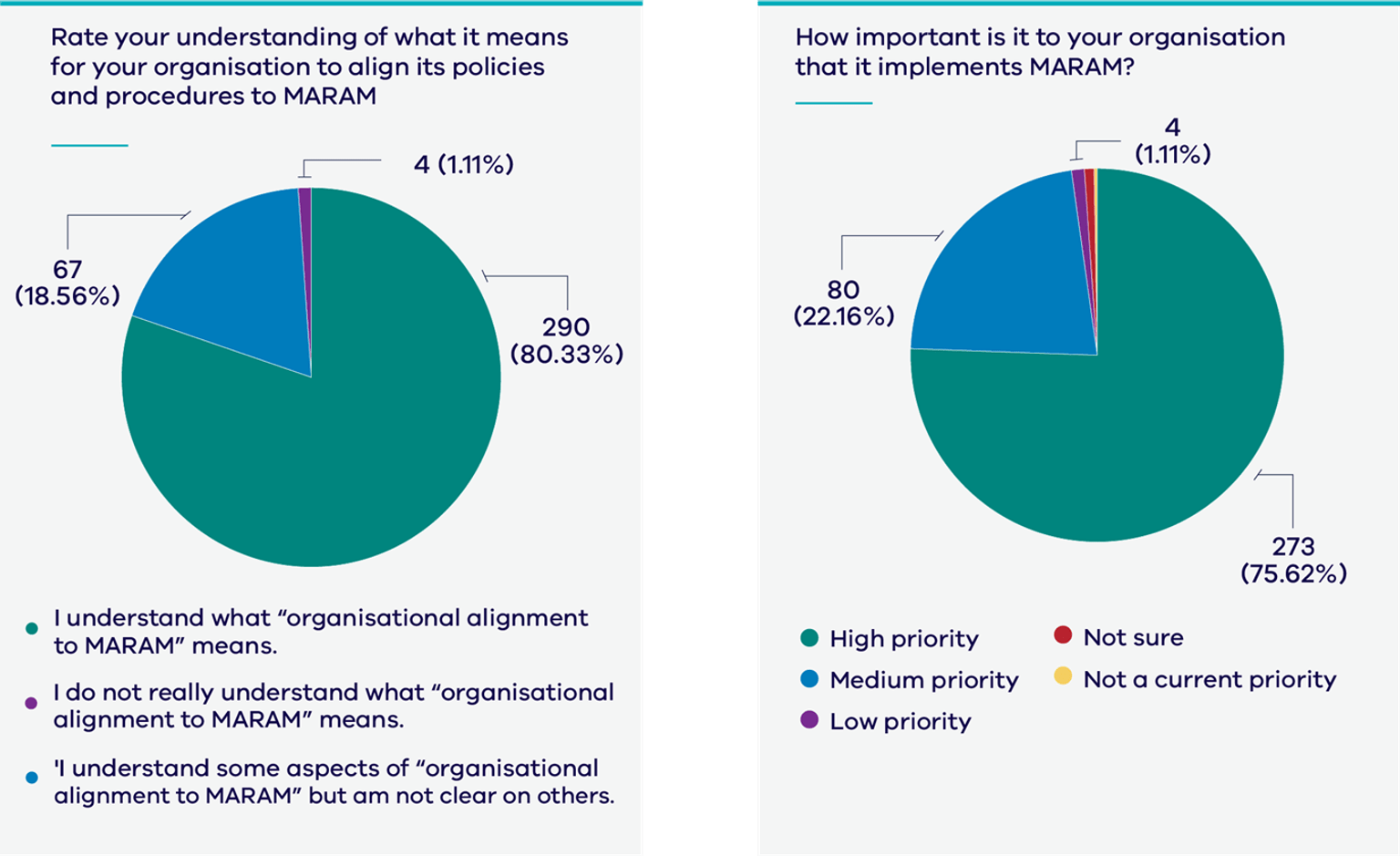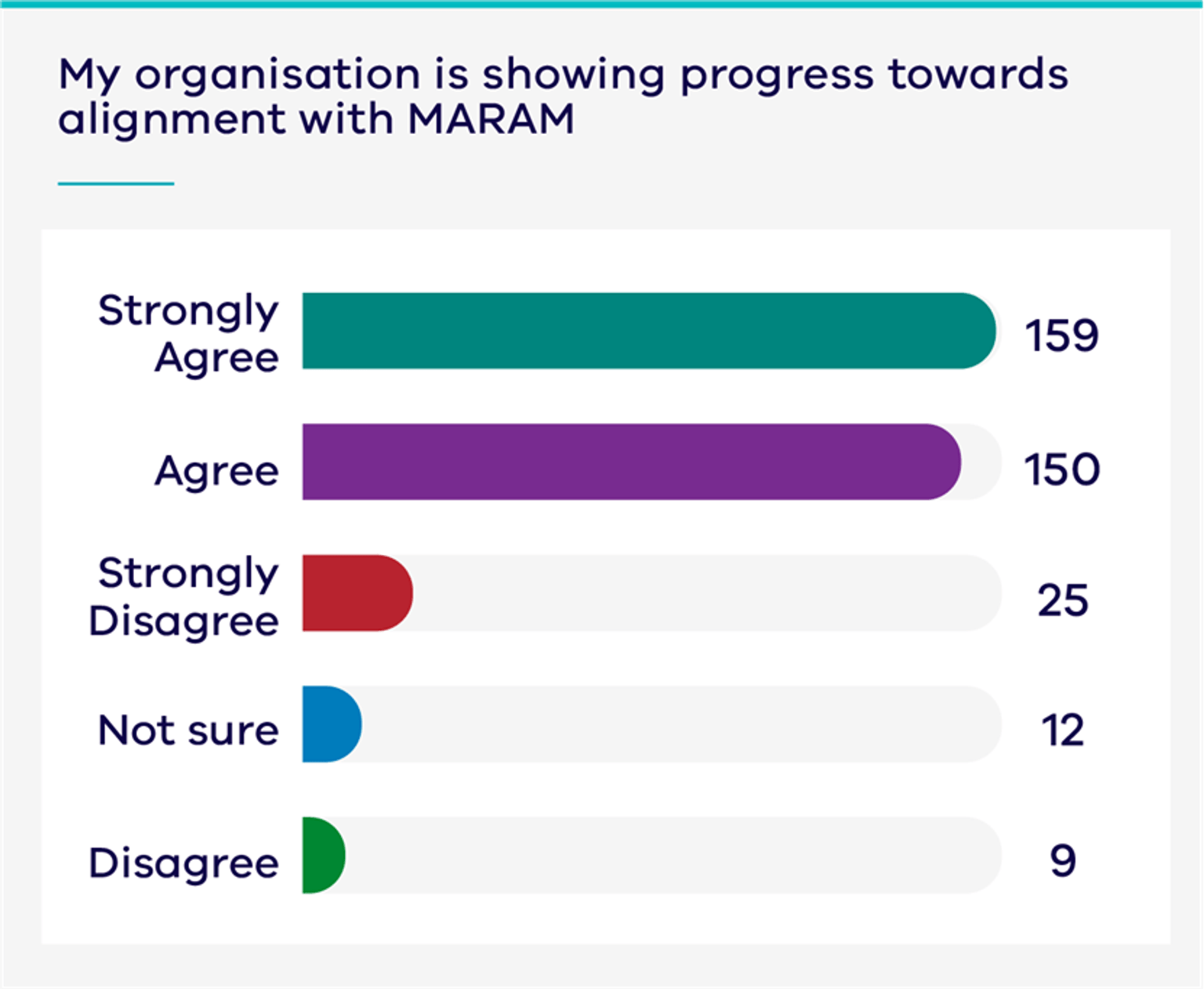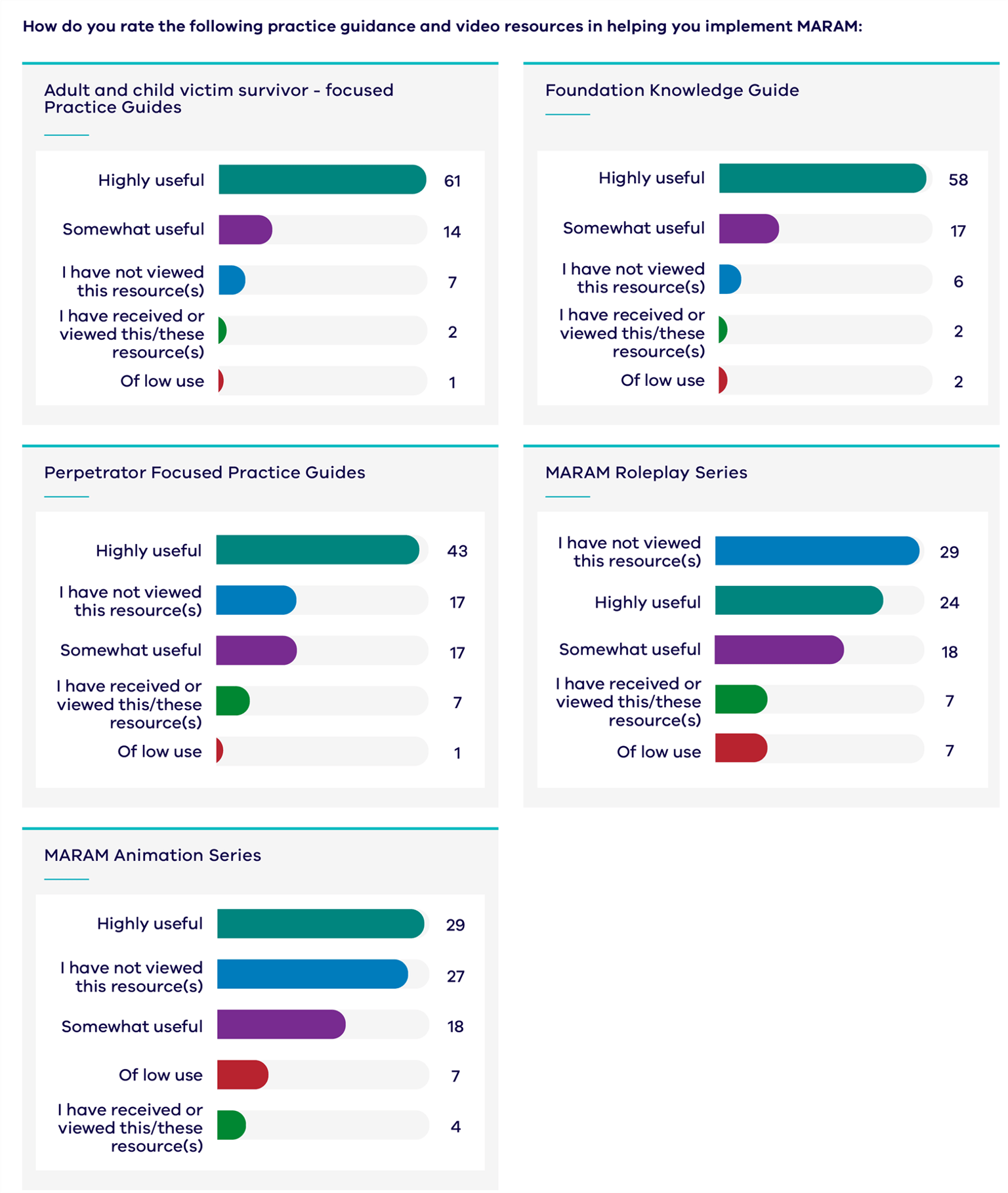Family Safety Victoria conducts an annual survey of framework organisations. The survey seeks to understand:
- the progress of implementation across different sectors
- how sectors can be supported to keep improving MARAM implementation.
Family Safety Victoria released the third annual MARAM Framework survey during this reporting period.
Across sectors
The survey was completed by 361 organisational leaders engaged in MARAM implementation activities across multiple sectors. It represents more than 600 MARAM-prescribed workforces and services.
The response in 2022–23 rate is 49 per cent higher than the previous year. This is mostly due to much higher engagement from leaders in the health sector.
Demographics
Most respondents are employed in health (42 per cent) and human services (26 per cent). They come from large or medium size organisations that provide metropolitan, metropolitan wide and/or state-wide services. 74 per cent of surveyed leaders are involved in policy, practice, and capacity development. Representation from the education and justice workforces was limited.
Supports received
Leaders indicated their organisations have received a variety of supports, communications, and training from Family Safety Victoria and departments to assist with MARAM alignment:
- 49 per cent stated they have received organisational supports from Safe and Equal
- 66 per cent have received accredited MARAM training
- 51 per cent have completed eLearns (identification and intermediate)
- 46 per cent have attended facilitated non-accredited MARAM training.
Most leaders (more than 90 per cent) also reported an understanding of obligations and responsibilities under MARAM and assessed MARAM alignment to be a high priority in their organisation (Figure 4).
Key organisational resources for MARAM, FVISS and CISS alignment appear to be considered useful, while some leaders are unaware of some newer or supportive materials.
Regarding internal organisational supports for alignment, most respondents agreed or strongly agreed that:
- they have been supported (88 per cent)
- organisational culture supports alignment (90 per cent)
- there is clear MARAM alignment leadership (79 per cent).
However, 15 per cent disagreed that there are effective continuous improvement processes, and 13 per cent disagreed that there is visible leadership and accountability.
Alignment progress
The great majority of respondents (87 per cent) agreed or strongly agreed with the statement that ‘their organisation is showing progress towards alignment with MARAM’.
Most respondents (80 per cent) reported that their organisations either ‘have or are creating/adapting a change management plan for implementing MARAM’. However, 20 per cent of respondents reported no change management plan for MARAM implementation.
Pleasingly, 100 per cent of ACCOs (33 respondents) reported either ‘having or have created/adapting a change management plan for implementing MARAM’. Additional findings include:
- 78 per cent of respondents agreed or strongly agreed with the statement that ‘professionals in their organisation understand information sharing responsibilities’
- 90 per cent of respondents agreed or strongly agreed with the statement that ‘professionals in their organisation are aware of MARAM’
- 88 per cent of respondents agreed or strongly agreed with the statement that ‘professionals in their organisation are aware of victim survivor and perpetrator referral services’.
Challenges
Respondents were also asked about MARAM alignment challenges. The most common theme across responses was a lack of time and resources.
Specialist services
Of the 361 responses to the survey, 85 respondents reported working in a state-funded specialist family violence or sexual assault service.
Demographics
The 85 specialist leaders that responded to the survey are employed in the human services and ACCO sectors and mostly come from large or medium size organisations that provide state-wide and metropolitan services. 84 per cent of these leaders are ‘always involved’ in policy, practice and capacity development.
Supports received
Specialist leaders and their organisations have received a variety of supports, communications and training. 80 per cent of respondents indicate having received organisational supports from Safe and Equal. 68 per cent of respondents indicate their organisations having received accredited MARAM training, 55 per cent indicate attendance of non-accredited MARAM training and 47 per cent attendance of Leading Alignment Training.
All (100 per cent) leaders reported having an ‘understanding of obligations and responsibilities under MARAM’ and most (99 per cent) place alignment as a high or medium priority. Practice guidance for MARAM appears to be considered highly or somewhat useful (more than 70 per cent of respondents), with some leaders not having viewed the roleplay and animation series.
Most respondents agree or strongly agree that they have been internally supported (95 per cent), organisational culture supports alignment (94 per cent), there is clear alignment leadership (90 per cent), there are continuous improvement processes (85 per cent), processes that enable MARAM responsibilities (98 per cent), and the organisation is prepared and supported to align (93 per cent).
Alignment progress
The great majority of respondents (91 per cent) agree or strongly agree with the statement that their organisation is ‘showing progress towards alignment with MARAM’.
The greater proportion of respondents (89 per cent) report that their organisations either have or are creating/adapting a change management plan for implementing MARAM.
Most respondents seem to agree or strongly agree that they have been supported (95 per cent), organisational culture supports alignment (94 per cent), and that there is clear alignment leadership (90 per cent).
Table 2 demonstrates that the majority of specialist service leaders appear to have taken the key foundational and intermediate steps for organisational alignment, while it does appear that more advanced alignment activities are still in progress.
Challenges
Lack of staff time and lack of resources were flagged by respondents as key challenges to alignment.
Table 2: WoVG alignment: Activities that you and/or your organisation has undertaken to align to MARAM
| Activity | Percent |
|---|---|
| Read the MARAM Framework and/or any other available MARAM supporting materials, guides and other reference documents provided by FSV and/or your funding departments | 80 |
| Considered the impact of MARAM on your organisation’s day-to-day operations | 78 |
| Commenced updating and/or creating new policies, procedures, practice guidelines to align with MARAM | 75 |
| Commenced updating and/or creating new tools and forms to align with MARAM | 74 |
| Established a group or identified an individual within your organisation to oversee and support the implementation of MARAM | 72 |
| Identified or supported relevant professionals to attend MARAM training delivered by Safe & Equal, your funding department or other service-specific family violence training | 69 |
| Identified any changes that will be required to current client or patient information gathering, documentation, storage and reporting to enable organisational alignment with MARAM | 68 |
| Implemented or updated a family violence referral protocol, agreement or guideline to align with MARAM | 66 |
| Determined which MARAM responsibilities apply to which professionals in your organisation and communicated this to relevant staff | 65 |
| Identified opportunities for greater collaboration with agencies in your local area for assessing and managing family violence risk | 64 |
| Created formal or informal partnerships and networks across your local area for collaboration in assessing and managing family violence risk | 62 |
| Developed an organisational implementation plan | 57 |
| Updated current staff position descriptions to reflect MARAM responsibilities | 55 |
| Planned or recruited new positions to assist with organisational alignment with MARAM and increase workforce capability in line with MARAM responsibilities | 47 |
| We have not yet undertaken any activities to align to MARAM | 0 |
Summary of progress
MARAM Annual Survey results indicate that the majority of responding organisations are progressing towards MARAM alignment and that alignment remains a priority. The vast majority (80 per cent) of respondents indicate that their organisations have commenced key steps to alignment and change management activities.
At the same time, demand on the service system has generally increased. Reports of family violence steadily increased since 2017[2]. This is in part because our reforms made it easier for people to identify family violence, report it and seek help. There are more entry points for victim survivors to seek help, including through Victoria Police, The Orange Door network and Safe Steps. More professionals understand their role in identifying and responding to family violence as a result of the MARAM and Information Sharing reforms[3].
The COVID-19 pandemic may also have contributed to this increase. Family violence workers reported more first-time reports of family violence during the pandemic.
In addition, many prescribed organisations are in sectors that are experiencing broader workforce challenges that place additional demands on a limited number of staff.
This context helps to explain why workload issues and organisational funding are noted as barriers to alignment by a small percentage of survey respondents. To address this, support to operationalise MARAM is being provided through the MARAMIS Sector Capacity Building Grants program (see Chapter 8), and ongoing guidance from relevant departments. Surveyed leaders are more aware of alignment support from funded sector peaks, and support received from Safe and Equal, CFECFW and NTV has increased in comparison to the previous year.
The release of the MARAM Maturity Model (See Chapter 6) will further support prescribed organisations to self-assess and benchmark their progress throughout their MARAM alignment journey.
References
Updated


